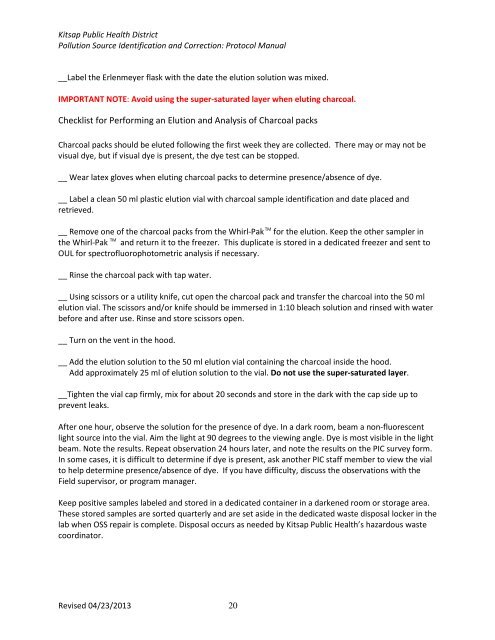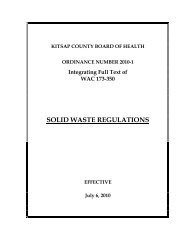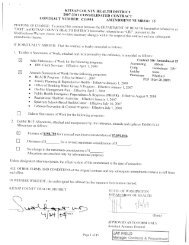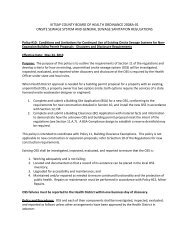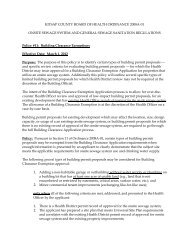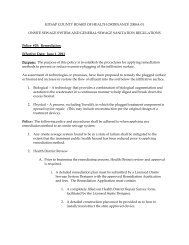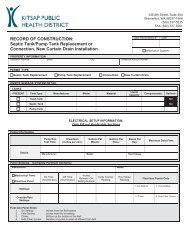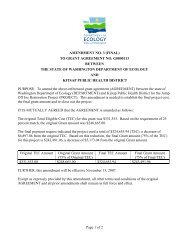(PIC) Protocol Manual - Kitsap Public Health District
(PIC) Protocol Manual - Kitsap Public Health District
(PIC) Protocol Manual - Kitsap Public Health District
Create successful ePaper yourself
Turn your PDF publications into a flip-book with our unique Google optimized e-Paper software.
<strong>Kitsap</strong> <strong>Public</strong> <strong>Health</strong> <strong>District</strong><br />
Pollution Source Identification and Correction: <strong>Protocol</strong> <strong>Manual</strong><br />
__Label the Erlenmeyer flask with the date the elution solution was mixed.<br />
IMPORTANT NOTE: Avoid using the super-saturated layer when eluting charcoal.<br />
Checklist for Performing an Elution and Analysis of Charcoal packs<br />
Charcoal packs should be eluted following the first week they are collected. There may or may not be<br />
visual dye, but if visual dye is present, the dye test can be stopped.<br />
__ Wear latex gloves when eluting charcoal packs to determine presence/absence of dye.<br />
__ Label a clean 50 ml plastic elution vial with charcoal sample identification and date placed and<br />
retrieved.<br />
__ Remove one of the charcoal packs from the Whirl-Pak TM for the elution. Keep the other sampler in<br />
the Whirl-Pak TM and return it to the freezer. This duplicate is stored in a dedicated freezer and sent to<br />
OUL for spectrofluorophotometric analysis if necessary.<br />
__ Rinse the charcoal pack with tap water.<br />
__ Using scissors or a utility knife, cut open the charcoal pack and transfer the charcoal into the 50 ml<br />
elution vial. The scissors and/or knife should be immersed in 1:10 bleach solution and rinsed with water<br />
before and after use. Rinse and store scissors open.<br />
__ Turn on the vent in the hood.<br />
__ Add the elution solution to the 50 ml elution vial containing the charcoal inside the hood.<br />
Add approximately 25 ml of elution solution to the vial. Do not use the super-saturated layer.<br />
__Tighten the vial cap firmly, mix for about 20 seconds and store in the dark with the cap side up to<br />
prevent leaks.<br />
After one hour, observe the solution for the presence of dye. In a dark room, beam a non-fluorescent<br />
light source into the vial. Aim the light at 90 degrees to the viewing angle. Dye is most visible in the light<br />
beam. Note the results. Repeat observation 24 hours later, and note the results on the <strong>PIC</strong> survey form.<br />
In some cases, it is difficult to determine if dye is present, ask another <strong>PIC</strong> staff member to view the vial<br />
to help determine presence/absence of dye. If you have difficulty, discuss the observations with the<br />
Field supervisor, or program manager.<br />
Keep positive samples labeled and stored in a dedicated container in a darkened room or storage area.<br />
These stored samples are sorted quarterly and are set aside in the dedicated waste disposal locker in the<br />
lab when OSS repair is complete. Disposal occurs as needed by <strong>Kitsap</strong> <strong>Public</strong> <strong>Health</strong>’s hazardous waste<br />
coordinator.<br />
Revised 04/23/2013 20


